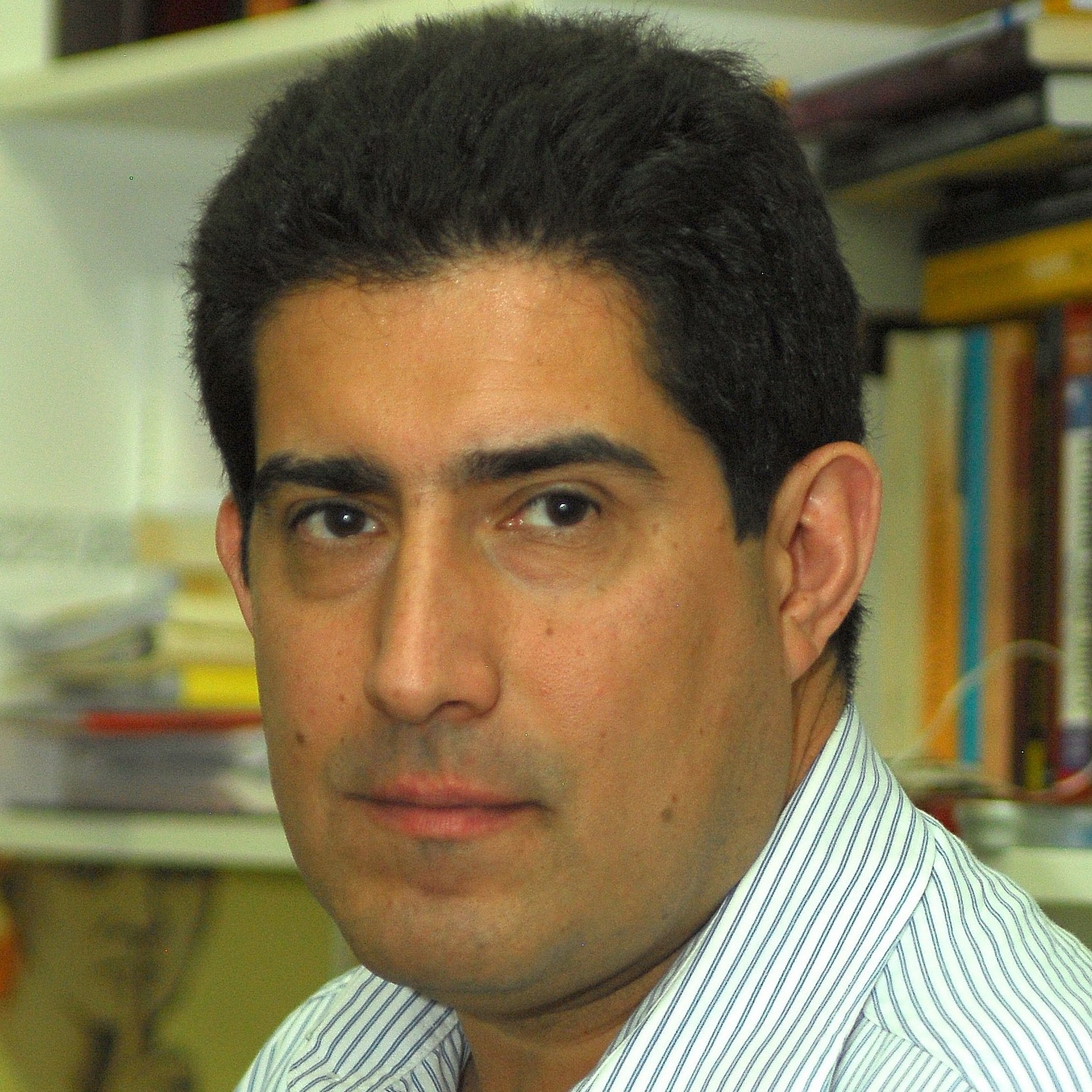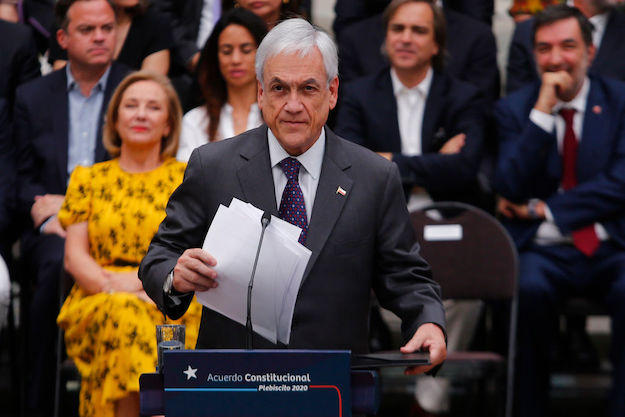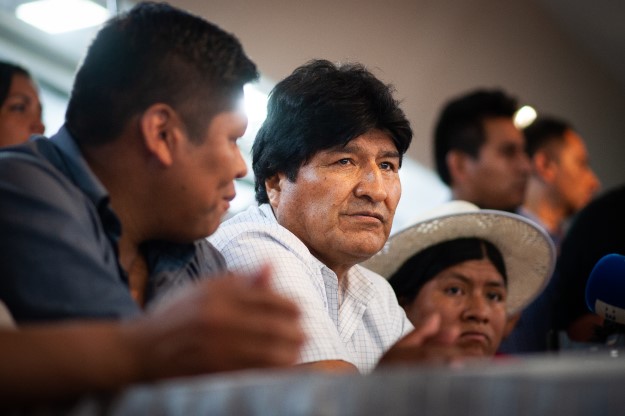SANTIAGO – Unlike people, countries cannot commit suicide. But Chileans’ response to the riots that erupted in late October, and have continued with varying levels of violence, has been profoundly self-destructive nonetheless. Time is running out to avert a disaster.
As I wrote for Americas Quarterly last October, the unrest was triggered by “frustration at the gate of the promised land” – the feeling, shared by many Chileans, that they have been denied the full benefits, rights and services of a true middle-class country. I believed then, and I still believe today, that many of these grievances are justified. “An abusive elite, an unresponsive government and an unkept promise of meritocracy and equal opportunity” remain among our biggest challenges. Deep change is necessary; without it, Chile will fail to complete its journey of the last 30 years and graduate to high-income level status.
Click here to hear Navia discuss this column on the new Americas Quarterly podcast
Yet most Chileans appear to have wrongly concluded that our 1980 Constitution, which was drafted during the dictatorship of Augusto Pinochet, is the main source of our country’s ills. If an April 26 referendum passes, as polls currently suggest it will, the Chilean people will embark on a two-year long process to write a new Constitution that will be full of uncertainty, put a great deal of normal life (including economic activity and investment) on hold, and likely yield a document that is not substantially different in content from our current charter. As I will explain below, the outcome of this process may well be the opposite of what its supporters intend: A country that is less stable, less equal, and more closely resembles some of our less stable Latin American peers.
Indeed, there is a real risk that this process will kill the proverbial goose that laid the golden egg.
The devil is in the details
When the riots first erupted in Chile in mid-October, I had a pretty optimistic view of the situation:
“The bad news is that people are upset, disappointed and angry. The good news is that Chile is in a good position to adopt inclusive reforms that promote social justice, defend markets (rather than business or special interests) and level the playing field. … If the Chilean elites relinquish many of their privileges and accept that meritocracy means that while some move up others move down, Chile will have shown the way for other Latin American countries to make the transition from middle-income to high-income status.”
After a couple of weeks of erratic responses by President Sebastián Piñera’s government, right-wing ruling coalition parties and most left-wing opposition parties agreed on an Agreement for Peace and a New Constitution. The agreement called for increasing social spending and outlined a roadmap for a constitutional process that would become the basis for a new social contract. In other words, a roadmap for universal access to the promised land for all Chileans.
Even that sounded good in practice, as I also wrote for AQ and elsewhere. But the devil is always in the details. As the fine print of the plan became known, and additional details were defined by a technical commission and by Congress, the flaws and potential pratfalls of the next two years became clear.
The April 26 referendum will consist of two questions. The first is “Do you want a new constitution?” The options are “Reject” or “Approve,” and polls suggest about 70% of Chileans currently plan to vote for the latter. Since voting is non-mandatory, it is unclear how many people will vote; in recent presidential elections, turnout has fluctuated between 50-60%. Turnout tends to be higher among older, more educated and higher income voters, who are less inclined to support the constitutional process. So the result of the April plebiscite might be closer than polls currently predict – but it still seems set to pass.
The second question begins to unveil the improvised and perhaps rushed nature of this process that Chileans seem ready to plunge into. The question reads: “What kind of body should draft the new constitution?” Here, the options are “Mixed Convention” and “Constitutional Convention.” A “mixed convention” would lead to a 172-member convention where 86 members would be appointed by the current congress and 86 would be democratically elected. A “constitutional convention” would lead to a fully elected 155-member convention. In theory, since Congress has less than 5% approval, the fully elected convention should be the logical choice for most people. Yet, because there has been a lively debate on whether the convention should have gender parity (that is, equal representation of men and women), many people wrongly believe a “mixed convention” refers to a body where that is the case. Since there is high popular support for gender parity, the unexpectedly high support in polls for a mixed convention might be the result of confusion among people as to what “mixed convention” really means.
It only gets more hackneyed from there. The victory of the “Approve” vote would formally start the constitutional process. A constitutional convention election would take place on Oct. 25, 2020. That would coincide with mayoral and council member elections in Chile’s 345 municipalities and gubernatorial elections (for the first time in Chile’s history) in its 16 regions. As a result, ballots will have a record-breaking number of candidates. If parties form five or six multiparty lists – as has been the norm in recent elections – voters will have to choose from among no fewer than six mayoral candidates, 36 council member candidates and 36 constitutional convention candidates. With such a long list of candidates, name recognition will play a big role. Popular mayors and local politicians will use that name recognition to their advantage. Why does this matter? Many Chileans who today hope that the constitutional convention will feature little-known constitutional law scholars or intellectuals, who will engage in fruitful and intellectually rich deliberations, may be in for a surprise. Instead, voters are likely to elect members with famous last names at the local level or artists, sportspersons or otherwise well-known candidates in their respective districts.
The constitutional convention would begin its deliberations in late November 2020. The convention would have a nine-month mandate (and an additional three-month extension if needed). Provided that the convention respects the deadline (after all, a constitutional convention has constituent power and can thus ignore the mandate under which it was convened, like the Philadelphia convention of 1787), a new constitution will be presented to Chileans in late November 2021. An exit referendum would then be held, probably in January or March 2022. In that referendum, Chileans would vote to accept or reject the new constitution proposed. That voting would be mandatory. If the Yes vote wins, the new constitution would come into effect. If the No vote wins, the current constitution would remain in place.
Unfortunately, the electoral calendar will get in the way – and complicate things to an almost unthinkable degree. Chile has legislative and presidential elections scheduled for Nov. 21, 2021. If no candidate wins more than 50% of the votes in the first-round vote, a runoff presidential election will be held on Dec. 19, 2021. In addition, there will be presidential primaries in July 2021. Thus, the constitutional convention will be drafting the new constitution at the same time as the new presidential election cycle is unfolding. It is difficult to imagine that the two processes will not adversely influence each other. Presidential candidates will be actively opining on the issues being discussed by the constitutional convention and the convention will inevitably react to voter intention polls for the presidential election.
The guidelines for the constitutional convention establish a two-thirds majority requirement to adopt its own rules. Thus, it seems safe to expect that the constitutional convention will establish a two-thirds majority requirement to pass the content of the new constitution. Many scholars and advocates have naively claimed that such a requirement will lead to the drafting of a minimalist constitution – one that describes principles in general terms and does not go into too many specifics, in order to gain broad support. Yet, a possible alternate outcome of a two-thirds majority requirement is that the constitution ends up being a maximalist document – one that includes a little bit for everyone to be satisfied so that it can have enough support to meet the two-thirds majority requirement. The three-fifths filibuster-proof majority in the United States Senate is a good indicator of what normally happens when high thresholds are required for legislation. Normally, that leads to omnibus bills – bills that include special concessions to individual senators to prevent a filibuster effort to block passage.
Since all the members of the constitutional convention would have an incentive to produce a text that can be presented to the nation by late 2021, the new Chilean constitution might end up resembling an Ekeko (the Andean god of abundance that brings with him a little bit of everything). If previous constitutional processes in Latin America are any hint, the maximalist constitution is the more likely outcome.
There is a better way
More than concern for the rules of the constitutional process or the technicalities of the legislative process, I am worried that Chileans’ overwhelming support for a new charter may reflect tragically misplaced expectations. Indeed, society may not fully understand what a constitution is and what a constitution does.
When Chileans explain why they want a new constitution, they point to their demand to expand social rights. They want a new constitution because they want better pensions, higher salaries, better health care and more rights as citizens and consumers. Most people are not familiar with the content of the current constitution, but they blame it for their dissatisfaction with the way democracy works. Going back to my AQ piece in October, Chileans believe that the 1980 Pinochet constitution prevents them from entering the promised land.
However, the history of Latin America clearly shows that new constitutions do not result in more economic development or lower levels of inequality – after all, the region has a world record of writing new constitutions, but remains underdeveloped and unequal. Putting more rights into the constitution does not mean those rights will be enforced. The provision of social rights – in particular – depends much more on sustained economic development than on enshrining those rights in any document. Constitutions can be declarations of intent – a description of the country people want rather than the country people have – but they are neither necessary nor sufficient conditions to achieve more social and economic inclusion.
Unquestionably, the 1980 Constitution in Chile has an illegitimate origin. Promulgated under Pinochet, the constitution reminds many Chileans of the atrocities of the military dictatorship. Yet, the admirable lesson that Chile offers the world is that you can build a stable democracy out of a constitution that was originally designed to obstruct democracy. When democracy was restored in 1990, the constitution was a straitjacket that hindered democratic development. But over the past 3 decades, Chile made impressive progress in democratic consolidation, economic development, poverty reduction and marginally reduced inequality. There is much more that needs to be done, but Chile stands out in the region as a success story of democratic consolidation and social inclusion.
From 1990 to 2005, successive democratic governments focused their efforts on reforming the constitution. All the authoritarian enclaves put in place by the military dictatorship were eliminated. More than 45 reforms were implemented, including a major set of reforms in 2005, under President Ricardo Lagos. Yet, after the death of Pinochet in late 2006, calls to draft a new constitution began to emerge – and intensified following the 2009 presidential election. As Pinochet died without being sentenced for the crimes committed by his dictatorship, many Chileans might want to right the wrongs of the past by abolishing Pinochet’s constitution.
But when those who advocate for a new constitution produce a laundry list of changes they want, the list is rather short and simple: recognition of indigenous peoples, reforming the constitutional tribunal, expanding social rights and giving the state attributions to engage in productive sector activities. Since all those are constitutional debates that also exist in other democracies, the problem is not really the content of the constitution as much as its origin.
Drafting a whole new constitution that will end up being similar to the current text might be a solution to correct the illegitimacy of origin of the current constitution. Yet, given the way in which the constitutional process has been drafted and the two-year calendar that constitutional change will entail, the cost of this redemption effort seems too high. Indeed, it may simply end in frustrated expectations – and cause society to become even angrier.
Already, we’ve seen how the uncertainty generated by the process has taken its toll on Chile’s economy. Activity crashed after the protests erupted in October, and as a result GDP probably only grew 1% in 2019, a huge comedown from 4% growth the year before. Numerous investments were put on hold, and consumers delayed big purchases. Many analysts expect the uncertainty to continue throughout 2020, as both street violence and political infighting rage unabated. The International Monetary Fund predicted in January that Chile’s economy would grow just 0.9% this year – a lower forecast than it had for Mexico, which raises the question: Can Chile really take two years of this? Sure, activity may pick up a bit – but it’s hard to imagine a return to full growth during a period when the country’s whole charter is up in the air. As a result, the country will be postponing the very economic growth and dynamism that could actually provide for better pensions, salaries and healthcare.
There is a better way, and one that does not involve a new constitution. Chile can resort to other means to reduce inequality and promote social inclusion. It can reform its tax system in order to collect more revenues, make changes to the pension system, provide more support for schools, and take other measures to support and nurture its middle class. This process won’t be easy – and it will lack the obvious drama and glitz of a new charter. But that is better than risking the death of the very dynamism that brought Chile to the gates of the promised land in the first place.
—
Navia is a professor of liberal studies at NYU and professor of political science at Diego Portales University in Chile









